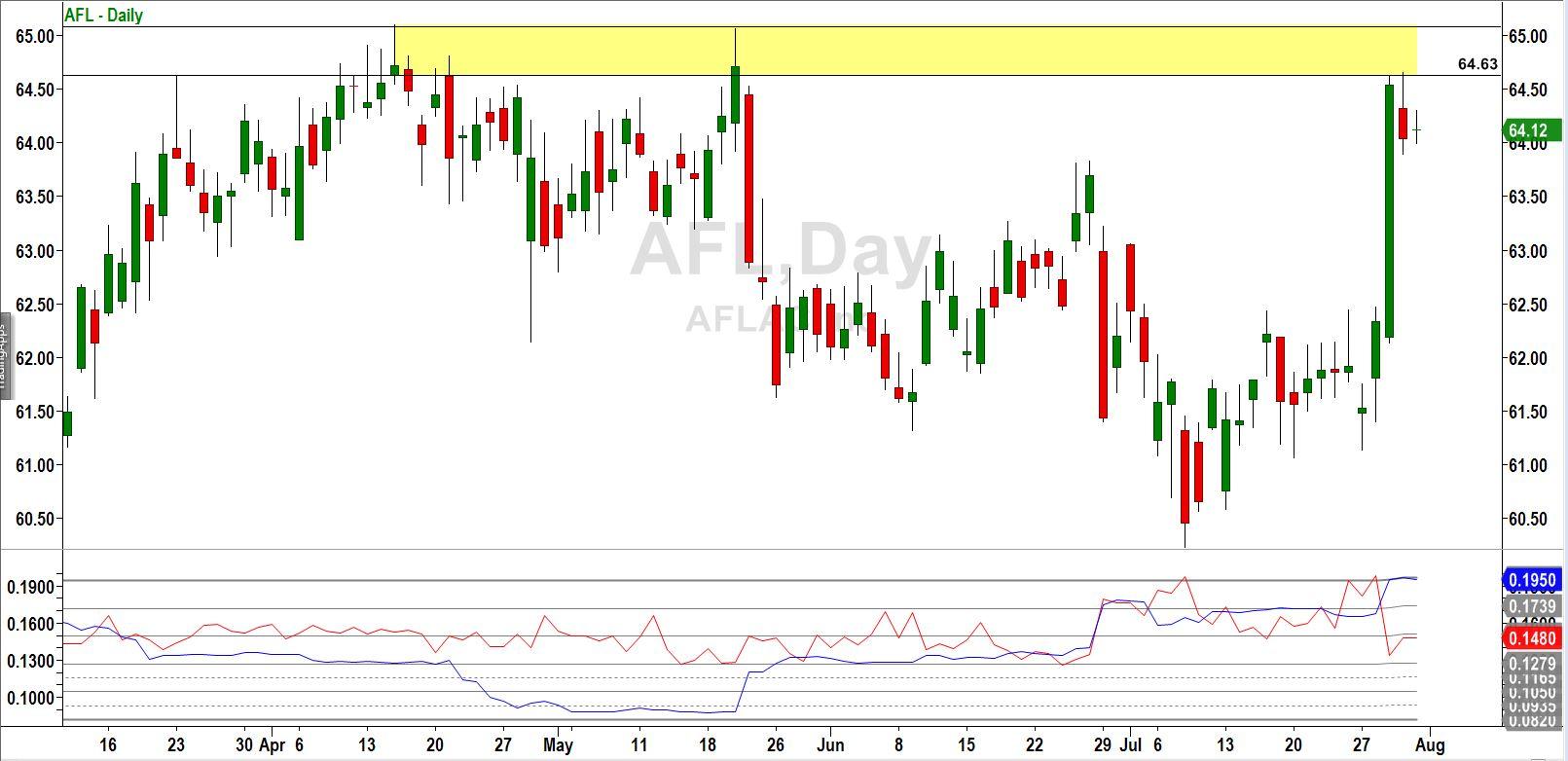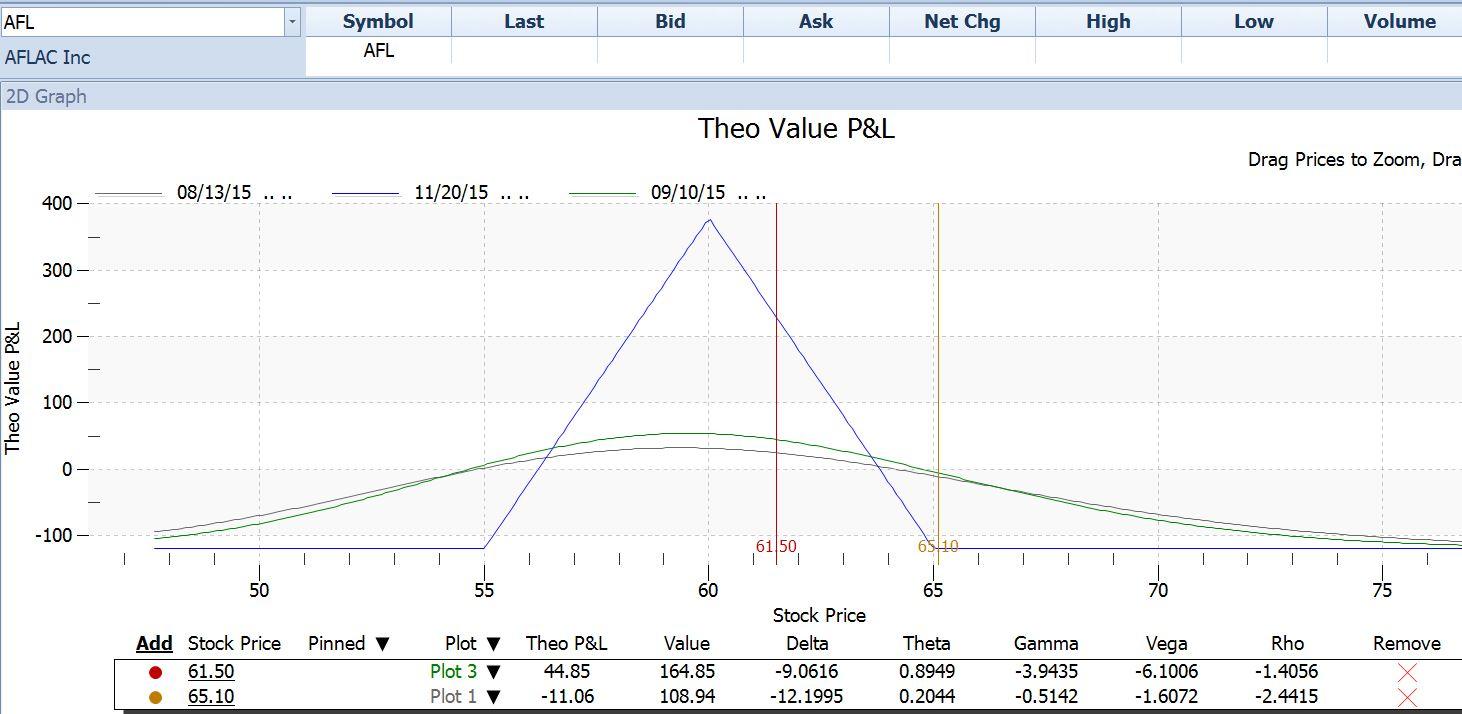Options give us some great ways to fit our trading approach to the current market conditions.
In a previous article we looked at a type of option spread called a directional butterfly. This trade is designed to make money if a stock moves in the direction we expect – no surprise there. What this spread does is to make it inexpensive to make the trade and limit our risk in case the stock moves against us.
The opportunity we were looking at involved the stock of AFLAC, Inc. on July 30. Its chart looked like this:
We were looking at a bearish opportunity: we thought most likely that the stock would fail to break through its recent highs around $65.10 and could drop back to its recent breakout level around $61.50 within a few weeks.
As an alternative to selling the stock short, we considered a directional put butterfly which involved three components:
Long one November $65 put – the moneymaker.
Short two November $60 puts – the offsets. These reduced the cost of the trade and reduced our exposure to changes in volatility. They also nearly eliminated the effect of time decay that the $65 put alone would have suffered.
Long one November $55 put – the protective unit. This very cheap option made this into a limited-risk trade.
The total cost of this spread was $120 per 100-share unit including all four options. This was our maximum loss on this trade if we used no protective stops and held it for the whole four months. Our plan would cut down that $120 risk considerably.
First, we would plan to exit the trade immediately if AFLAC traded above its recent high at $65.10. If that happened, it would indicate that our opinion about its inability to do so had been incorrect and there would be no more reason to be in the trade.
Second, we would not hold the trade for the full four months. If AFLAC hadn’t made its move within a month we would exit in any case.
Although setting stop-loss orders would not reduce the amount of cash required to enter the trade (it would still be $120 per 100-share lot), these two steps cut down our maximum risk from $120 to about $11 per spread. The profit potential if AFLAC hit our $61.50 target was over $44 per contract, four times the $11 risk.
Below is the Profit/Loss graph of this position:
The horizontal axis is the stock price and the vertical axis is profit or loss on the position (given its $120 cost). The gray curved line shows P/L at any stock price if reached today. The green curved line shows P/L at any stock price in a month’s time.
We used today’s line (gray) to determine loss on the position at our $65.10 stop-loss price. The second row in the table above indicated that loss at $11.06 (in the “Theo P&L” column).
We used the green line, which indicates P/L a month from now, to determine our profit. This is because we believed it could take that long to reach our target. The first row in the table indicates the P&L at that price as $44.85. The profit could be a bit higher if AFLAC were to drop lower than our $61.50 target.
Although the directional butterfly has several moving parts, it can be a good solution to gaining profit from a stock move at a reasonable cost and with limited risk.
This is just one of many strategies that we teach in our on-location and online classes. With the right education we can shape an option strategy to fit just about any market condition.
This content is intended to provide educational information only. This information should not be construed as individual or customized legal, tax, financial or investment services. As each individual's situation is unique, a qualified professional should be consulted before making legal, tax, financial and investment decisions. The educational information provided in this article does not comprise any course or a part of any course that may be used as an educational credit for any certification purpose and will not prepare any User to be accredited for any licenses in any industry and will not prepare any User to get a job. Reproduced by permission from OTAcademy.com click here for Terms of Use: https://www.otacademy.com/about/terms
Editors’ Picks
EUR/USD edges lower toward 1.0700 post-US PCE

EUR/USD stays under modest bearish pressure but manages to hold above 1.0700 in the American session on Friday. The US Dollar (USD) gathers strength against its rivals after the stronger-than-forecast PCE inflation data, not allowing the pair to gain traction.
GBP/USD retreats to 1.2500 on renewed USD strength

GBP/USD lost its traction and turned negative on the day near 1.2500. Following the stronger-than-expected PCE inflation readings from the US, the USD stays resilient and makes it difficult for the pair to gather recovery momentum.
Gold struggles to hold above $2,350 following US inflation

Gold turned south and declined toward $2,340, erasing a large portion of its daily gains, as the USD benefited from PCE inflation data. The benchmark 10-year US yield, however, stays in negative territory and helps XAU/USD limit its losses.
Bitcoin Weekly Forecast: BTC’s next breakout could propel it to $80,000 Premium

Bitcoin’s recent price consolidation could be nearing its end as technical indicators and on-chain metrics suggest a potential upward breakout. However, this move would not be straightforward and could punish impatient investors.
Week ahead – Hawkish risk as Fed and NFP on tap, Eurozone data eyed too

Fed meets on Wednesday as US inflation stays elevated. Will Friday’s jobs report bring relief or more angst for the markets? Eurozone flash GDP and CPI numbers in focus for the Euro.
RECOMMENDED LESSONS
Making money in forex is easy if you know how the bankers trade!
Discover how to make money in forex is easy if you know how the bankers trade!
5 Forex News Events You Need To Know
In the fast moving world of currency markets, it is extremely important for new traders to know the list of important forex news...
Top 10 Chart Patterns Every Trader Should Know
Chart patterns are one of the most effective trading tools for a trader. They are pure price-action, and form on the basis of underlying buying and...
7 Ways to Avoid Forex Scams
The forex industry is recently seeing more and more scams. Here are 7 ways to avoid losing your money in such scams: Forex scams are becoming frequent. Michael Greenberg reports on luxurious expenses, including a submarine bought from the money taken from forex traders. Here’s another report of a forex fraud. So, how can we avoid falling in such forex scams?
What Are the 10 Fatal Mistakes Traders Make
Trading is exciting. Trading is hard. Trading is extremely hard. Some say that it takes more than 10,000 hours to master. Others believe that trading is the way to quick riches. They might be both wrong. What is important to know that no matter how experienced you are, mistakes will be part of the trading process.


